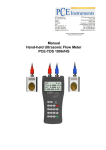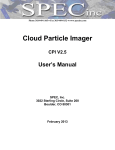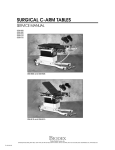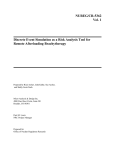Download HDR 1000 QA Tool
Transcript
HDR 1000 QA Tool REF 70008 STANDARD IMAGING, INC. 7601 Murphy Drive Middleton, WI 53562 May / 2004 ©2004 Standard Imaging, Inc. DOC #80012-04 TEL 800.261.4446 TEL 608.831.0025 FAX 608.831.2202 www.standardimaging.com R General Precautions ! CAUTION: Proper use of this device depends on careful reading of all instructions and labels. ! CAUTION: This device should never be submerged to clean or scrubbed with an abrasive cleaner. ! CAUTION: Insure source freely moves within secured catheter. Proper location of source is necessary to assure proper calibration. Warnings and Cautions alert users to dangerous conditions that can occur if instructions in the manual are not obeyed. Warnings are conditions that can cause injury to the operator, while Cautions can cause damage to the equipment. 2 Table of Contents PAGE 2 3 3 4 4 4 5 6 7 8 8 8 9 9 11 11 12 General Precautions Overview Wall Mount for QA Measurements Description Operation Procedure A. Initial Procedure B. Calibrations for Constant, K C. Standard QA Procedure Table 5 Documentation of Results Table 6 Table 7 Parts and Accessories List Maintenance Service Policy Customer Responsibility Warranty 7601 MURPHY DRIVE MIDDLETON, WI 53562 Overview Accurate delivery of doses using an high dose rate (HDR) brachytherapy remote afterloading system depends on predicting the strength of the radioactive source at the time of treatment, the precision and consistency of the timer, and the ability of the unit to position the source at the proper dwell location along the catheter. Periodic quality assurance on HDR machines is a part of the standard protocol of the user. The HDR QA tool for an HDR 1000 Plus well chamber is designed to verify the consistency of source positioning, dwell time accuracy and source activity. Wall Mount for QA Measurements A wall mount is available from Standard Imaging for convenient mounting and storage of the HDR 1000 ion chamber. It is important that the chamber be located in a consistent location for QA measurements. The QA tool can be placed in the open holder space in the wall mount that is next to the HDR 1000 chamber opening. The HDR 1000 chamber can be connected to a standard triax cable while mounted on the wall. Note: The HDR 1000 can be used mounted on the wall for QA measurements, but should not be used any closer than 25 cm to any wall for calibration purposes. (See Medical Physics 19: 1311-1314 (1992)). Refer to the Instruction Manual received with the HDR 1000 for calibration procedures. 3 Description Figure 1 shows a schematic drawing of the lead lined HDR QA tool insert. This tool is inserted in the HDR 1000 Plus well chamber in place of the standard source holder insert. The distance from the bottom of the tool to the center of the 4 mm spacer is 51 mm. The HDR QA tool insert tightly collimates the radiation received by the chamber to a narrow plane. When the source lies in that plane, the chamber responds with a large signal; when the source falls partially or completely out of the plane, the signal greatly diminishes. Figure 1: Schematic drawing of HDR QA Tool This response curve is shown in Figure 2. For checking positional accuracy, the high slope regions of Figure 2, designated point A, are the most useful. For checking dwell time and activity, a plateau, designated point B in Figure 2, rather than a peak is desired. With this tool, the source position verification, timer accuracy and consistency of the source activity can be measured in a simpler manner by using the method described below. Figure 2: Representative response curve using HDR QA Tool insert of Fig. 1. The high slope region is designated A and the plateau region is designated B. Operational Procedure A. Initial Procedure 1. Insert the HDR QA tool into the well of the HDR 1000 Ion chamber. 2. Insert the catheter from the HDR afterloading machine through the opening in the top of the HDR QA tool. Push the catheter to the bottom of the chamber and lock the catheter in place with the provided holding device. Secure the catheter with the knurled catheter holding device. Note: Take care not to kink the catheter and insure that the catheter is secured and unable to move. If possible dedicate a catheter to this purpose and once locked in place, let it remain in the QA tool. The catheter should have a gentle arc when connected to the HDR unit. Moving the HDR unit can result in differences in the recorded values; always keep the unit in the same position. For greater rigidity a needle catheter is recommended. 4 Operational Procedure 3. The first time the tool is used, take data to determine points A (slope) and B (plateau) as shown in Figure 2 to document the position on the HDR system. Point A should be where the reading equals about 0.5 of the difference between the maximum value and the trough value. Point B should lie in the middle of the maximum plateau. Program the HDR unit to begin 40 mm from the bottom of the well, and move by the finest increments to 60 mm from the bottom, stopping for 10 seconds at each dwell position. Record the current reading at each position. If your HDR unit is unable to determine millimeter sized steps, reprogram the unit starting with different beginning locations to fill in the readings between the first set of dwell positions. 4. Correct the readings for temperature and pressure. 5. Determine the values of the constant, K (See section B. “Calculations for constant, K” below), for points A and B, corrected to a standard temperature and pressure. When the HDR QA tool is first used, a determination of the value of K for each of points A and B as measured above, must be made; thereafter, it will be a constant for your HDR unit. Thus, thereafter, only measurements of points A and B need to be made. B. Calculations for constant, K Constant, K, can be determined from measurements of the charge and current at Points A and B. The concepts behind these calculations are given in Med. Phys. 22: 435-440 (1995). The following expression for a constant, K, can be determined from the measurements for each point taken above: 1) K(x, t) = Q(x,t) * Ctp /Aoe(−λτ) * t OR 2) K(x) = I(x) * Ctp /Aoe(−λτ) Where: K(x,t) is the function that relates the response of the system to x and time t; this function will be a constant for a given point of measurement. Q(x,t) is the charge measured when the source is in position x for time t, where x is the position of the source in the QA insert and t is the exposure time, if using a gated measurement system, or otherwise the effective time, adjusted for transittime effects. I(x) is the current measured when the source is at position x Ctp is the correction for temperature and atmospheric pressure for the ionization chamber. Ao is the source strength at the time of calibration of the Ir-192 source τ is the time since the calibration λ is the decay constant of Ir-192 When an analysis is done for the uncertainties associated with the parameters of measurement, the total contribution is equivalent to 0.7% (See Table 1 for uncertainties for individual measurements). Therefore, any changes in the value of K greater than 1.5% may be considered significant. Therefore, a 1 mm error in position would become approximately a 20% change in the current-based KA, or greater than 10 times the measurement uncertainty. The standard deviation of a number of trials without any changes has been shown to be within 1%. Table 1: Showing uncertainty in test of K. Test Uncertainty in Test Source Position Dwell Time Source Activity Consistency < 0.1 mm < 0.7 % < 0.7 % 5 Operational Procedure Table 2 lists the ranges of error for positioning based on the difference in the value of KA. If the determinations of ∆KA remain less than 10%, the error in positioning is < 0.5 mm. Table 3 has listed ranges of error based on the difference in the value of KB from the average value of KB. The values given in Table 3 are based on two standard deviation limits and the uncertainty analysis given above. For example, if all of the determinations of ∆KB remain within 1%, the user can be assured that the source activity calibration has remained constant to within 0.1Ci, and the error in the dwell time is less than 0.1 second (See Table 3). Table 4 is based on the value of ∆K and can be used to determine which item, e.g. source positioning or dwell time, is in error depending which value or values of K are out of criterion. Table 2: Deviation of KA and limits of error for QA Measurements QA Test Source Positioning ∆KA < 10 % 10 % < ∆KA < 20 % ∆KA > 20 % < 0.5 mm 0.5 < x < 1.0 mm > 1.0 mm Table 3: Deviation of KB and limits of error for QA Measurements QA Test Source Activity Dwell Time ∆KB < 1 % 1 % < ∆KB < 2 % ∆KB > 2 % < 0.1 Ci < 0.1 s 0.1 < A < 0.2 Ci 0.1 < t < 0.2 s > 0.2 Ci > 0.2 s Table 4: Table for determining item in error depending on difference in value(s) of K Source of error appears as Source Activity Dwell Time Source Positioning minor major ∆K(x)A Parameter ∆K(x) ∆K(x,t) ∆K(x)A/∆K(x)B off on off on off off on on off off on off on off off off Where: ∆K(x)A, ∆K(x)B are for current measurements and ∆K(x,t)B is an integrated measurement. On means ∆KB < 1%, and ∆KA < 10%, Off means ∆KB > 1% and ∆KA > 10%. 6 Operational Procedure Note that the values of K are unique for your chamber and the electrometer used. Your chamber and electrometer should be calibrated to give calibration values, e.g. Nx, unique to your setup. The Nx value and the electrometer correction factors must be used as a multiplier for Q and I in the above equations 1 and 2 for activity calibrations. If the timer is suspected to be in error, the timer accuracy can be determined at a plateau position, Point B, by measuring the charge accumulated in the amount of dwell time set on the HDR control. The measured amount of time can be calculated from equations 1 and 2 as follows: 3) Q (B, tset) = Q (B) + Q(transit) Where: Q(transit) is the reading accumulated while the source moves into, and returns from, its dwell position. Approaching this analogously to that typical of cobalt units, define an effective transit time, tef,tr such that 4) Where: β is a proportionality factor that should be equal to unity if the HDR timer is accurate tef,tr is the equivalent time to account for that part of the reading produced with the source in transit going to and returning from its dwell position tmeas can be calculated by 5) tmeas = Q(B, tset) / I(B) To solve for the unknowns, b and ttransit, two different set times must be measured. (See Table 5). An assumption could be made that for ease of use in daily performance of the timer check, the program should be stored on a program card or as a “standard” if the unit has these capabilities. Dwell times in such stored programs often increase exponentially over time to compensate for radioactive decay of the source. Thus, this procedure should not be done; see Med Phys 22: 435-440 (1995) for further explanations. tmeas = β tset + tef,tr Table 5: Example determining of β and ttransit of Equations 4 and 5 for 8 separate measurements. Date 24 May 1 June 2 June 3 June 8 June 9 June 10 June 11 June I(B) (nA) Q(B, t1) (nC) Q(924, t2) (nC) β ttransit (s) 11.780 11.170 11.030 10.890 10.260 10.080 10.180 10.160 62.85 59.70 59.45 58.15 54.95 54.65 54.75 54.05 121.90 115.70 114.10 112.20 105.80 104.45 104.95 104.50 1.003 1.003 0.991 0.993 0.991 0.988 0.986 0.993 0.32 0.33 0.44 0.38 0.40 0.48 0.45 0.35 0.994 0.006 0.39 0.06 Average Std Dev 7 Operational Procedure C. Standard QA Procedure 1. Set up catheter and QA Tool as described in steps A1 through A2. 3. Correct to a standard temperature and pressure. 2. Set the HDR unit to move the source to the selected points A and B from above. Take current measurements at these points. Then take a charge measurement each for times t1 and t2 (e.g. 10 seconds and 5 seconds) at point B. Record data and calculations on a chart as shown in Table 6. 4. Determine the day’s values of the constant, K, at points A and B. 5. Compare the day’s value for K to the initial value. Determine a percent difference for the present value of K versus this initial or average value for each measurement at points A, and B. Documentation of Results Sample QA charts are given in Tables 6 and 7 to retain a record of the QA measurements. In lieu of using these charts, columns can be added to the facility’s regular QA form. Table 6: QA Chart for HDR Source Date Initials HDR UNIT DISTANCE INDICATION Point A (current) KA (nA/Ci) Point B (current) KB (nA/Ci) KB (nC/Ci) Point B (integrated) QB(t1) (nC) QB(t2) (nC) QB(t2) (nC) 121.90 121.64 121.04 121.48 121.14 121.33 121.28 Table 7: QA Chart for HDR Source Date 1/18 1/19 1/20 1/21 1/24 1/25 1/26 Initials SCD SCD SCD SCD SCD SCD SCD HDR UNIT DISTANCE INDICATION Point A (current) KA (nA/Ci) Point B (current) KB (nA/Ci) KB (nC/s)/(Ci) Point B (integrated) QB(t1) (nC) 1.543 1.512 1.508 1.515 1.510 1.559 1.557 2.004 2.002 2.005 2.002 2.006 2.009 2.008 2.003 2.003 2.004 2.002 2.008 2.008 2.008 62.85 63.12 62.80 63.04 62.85 62.95 62.93 8 Parts and Accessories List REF Description 70008 70007 80012 10040 10041 30053 HDR QA Tool Wall Mount Bracket HDR QA Tool Instruction Manual O-Ring, QA Tool Torque Wrench, QA Tool Catheter Fixator, QA Tool Maintenance If assistance is desired in the proper disposal of this product (including accessories and components), after its useful life, please return to Standard Imaging. There are no servicable parts on the QA Tool Insert. 9 Notes 10 Service Policy Customer Responsibility If service, including recalibration, is required, please contact Standard Imaging’s Customer Service department by phone or email prior to shipping the product. Standard Imaging’s Customer Service and Technical Service staff will attempt to address the product issue via phone or email. If unable to address the issue, a return material authorization (RMA) number will be issued. With the RMA number, the product can be returned to Standard Imaging. It is the responsibility of the customer to properly package, insure and ship the product, with the RMA number clearly identified on the outside of the package. The customer must immediately file a claim with their carrier for any shipping damage or lost shipments. Return shipping and insurance is to be pre-paid or billed to the customer, and the customer may request a specific shipper. Items found to be out of warranty are subject to a minimum service fee of 1 hour labor (excluding recalibrations) for diagnostic efforts and require a purchase order (PO) before service is performed. With concurrence from customer, the product may be replaced if it is unserviceable or if the required service is cost prohibitive. Products incurring service charges may be held for payment. Standard Imaging does not provide loaner products. See the Standard Imaging Warranty and Customer Responsibility for additional information. This product and its components will perform properly and reliably only when operated and maintained in accordance with the instructions contained in this manual and accompanying labels. A defective device should not be used. Parts which may be broken or missing or are clearly worn, distorted or contaminated should be replaced immediately with genuine replacement parts manufactured by or made available from Standard Imaging Inc. ! CAUTION: Federal law in the U.S.A. and Canadian law restrict the sale, distribution, or use of this product to, by, or on the order of a licensed medical practitioner. The use of this product should be restricted to the supervision of a qualified medical physicist. Measurement of high activity radioactive sources is potentially hazardous and should be performed by qualified personnel. Should repair or replacement of this product become necessary after the warranty period, the customer should seek advice from Standard Imaging Inc. prior to such repair or replacement. If this product is in need of repair, it should not be used until all repairs have been made and the product is functioning properly and ready for use. After repair, the product may need to be calibrated. The owner of this product has sole responsibility for any malfunction resulting from abuse, improper use or maintenance, or repair by anyone other than Standard Imaging Inc. The information in this manual is subject to change without notice. No part of this manual may be copied or reproduced in any form or by any means without prior written consent of Standard Imaging Inc. 11 Warranty Standard Imaging, Inc. sells this product under the warranty herein set forth. The warranty is extended only to the buyer purchasing the product directly from Standard Imaging, Inc. or as a new product from an authorized dealer or distributor of Standard Imaging, Inc. For a period provided in the table below from the date of original delivery to the purchaser or a distributor, this Standard Imaging, Inc. product, provided in the table is warranted against functional defects in design, materials and workmanship, provided it is properly operated under conditions of normal use, and that repairs and replacements are made in accordance herewith. The foregoing warranty shall not apply if the product has been altered, disassembled or repaired other than by Standard Imaging, Inc. or if the product has been subject to abuse, misuse, negligence or accident. Product Standard Imaging Ionization Chambers Standard Imaging Well Chambers Standard Imaging Electrometers Standard Imaging Software Products All Other Standard Imaging Products Standard Imaging Custom Product Consumables Serviced Product Resale Products ADCL Product Calibration (Standard Imaging uses the UW-ADCL for recalibrations required under warranty) Warranty Period 2 years 2 years 2 years 1 year 1 year 90 days 90 days 90 days As defined by the Original Equipment Manufacturer 0 - 90 days = 100% of ADCL Calibration Costs 91 - 182 days = 75% of ADCL Calibration Costs 183 – 365 days = 50% of ADCL Calibration Costs 366 – 639 days = 25% of ADCL Calibration Costs (days from date of shipment to customer) Standard Imaging’s sole and exclusive obligation and the purchaser’s sole and exclusive remedy under the above warranties are, at Standard Imaging’s option, limited to repairing, replacing free of charge or revising labeling and manual content on, a product: (1) which contains a defect covered by the above warranties; (2) which are reported to Standard Imaging, Inc. not later than seven (7) days after the expiration date of the warranty period in the table; (3) which are returned to Standard Imaging, Inc. promptly after discovery of the defect; and (4) which are found to be defective upon examination by Standard Imaging Inc. Transportation related charges, (including, but not limited to shipping, customs, tariffs, taxes, and brokerage fees) to Standard Imaging are the buyer’s responsibility. This warranty extends to every part of the product except consumables (fuses, batteries, or glass breakage). Standard Imaging, Inc. shall not be otherwise liable for any damages, including but not limited to, incidental damages, consequential damages, or special damages. Repaired or replaced products are warranted for the balance of the original warranty period, or at least 90 days. This warranty is in lieu of all other warranties, express or implied, whether statutory or otherwise, including any implied warranty of fitness for a particular purpose. In no event shall Standard Imaging, Inc. be liable for any incidental or consequential damages resulting from the use, misuse or abuse of the product or caused by any defect, failure or malfunction of the product, whether a claim of such damages is based upon the warranty, contract, negligence, or otherwise. This warranty represents the current standard warranty of Standard Imaging, Inc. Please refer to the labeling or instruction manual of your Standard Imaging, Inc. product or the Standard Imaging, Inc. web page for any warranty conditions unique to the product. 12






















